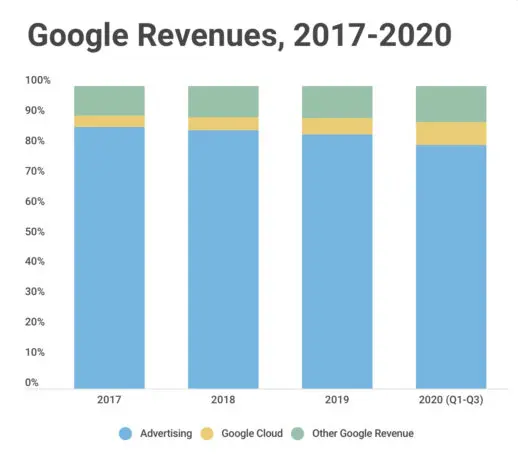There are two ways to look at Google’s recent announcement that it will discontinue unlimited Google Photos storage starting next June.
The first is Google’s official explanation: People are uploading a lot more photos and videos than they used to, making the service harder to sustain for free. “When we launched Google five years ago, the upload velocity that we had then, versus today’s mobile world, is a lot different,” Google Photos VP Shimrit Ben-Yair told me recently.
But there’s another explanation that Google didn’t make quite as explicit: The end of unlimited Google Photos storage marks a pivot of sorts for the search giant, away from being so overwhelmingly dependent on targeted ads as its dominant business model. The future of Google could be as much about subscription revenue as advertising, with Google Photos’ push for paid cloud storage as the centerpiece of those efforts.
Beyond the ad business
Google’s shift away from an ad-centric model isn’t entirely new. While advertising made up nearly 90% of the company’s revenues in 2015, that share has since fallen to 83.9% last year and 80.6% over the first nine months of 2020. Nonadvertising revenue comes from the apps and media people buy from the Google Play Store, sales of devices such as Pixel phones and Nest speakers, subscriptions to services such as YouTube TV, and Google’s enterprise business, which includes cloud computing services and business-class productivity tools.
Still, there are signs that Google may be accelerating those nonadvertising efforts, with subscription revenue as the focal point.
Last month, for instance, Google discontinued unlimited cloud storage for business users as part of its rebranding from G Suite to Google Workspace. Instead of getting unlimited storage for $12 per user per month, teams with at least five members will get 2 TB of storage per user at that price. Companies must pay $18 per month per user for 5 TB of storage, and Google doesn’t even advertise the price of unlimited storage, which it only offers through its sales department.

Google also sharply increased the price of its YouTube TV streaming bundle over the summer, from $50 per month to $65 per month. While other live TV services have also raised prices, and TV networks deserve most of the blame for making pay TV too expensive, the price hike shows that Google’s become more intent on making the service profitable.
Google’s also added a few new subscription services over the last year or so. In September 2019, it launched Play Pass, a $5-per-month bundle of Android apps and games from the Google Play Store. A couple of months later, it got into the cloud gaming business with Stadia. And just last month, Google started selling Pixel phones on a subscription basis to customers of its Google Fi wireless service, helping to ensure that they stay connected to the company’s cellular plans over the long haul.
All of this suggests that Google isn’t feeling as confident in the advertising business as it used to, and for good reason: Threats to its longstanding cash cow are everywhere.
On the regulatory front, the European Commission hasn’t held back from attacking Google’s advertising business. It fined the company roughly $1.7 billion for abusing its market power last year. In the United States, the Department of Justice has filed an antitrust lawsuit against Google, focused mainly on Google’s default search agreements with companies such as Apple and Mozilla.
And if Google was hoping for less scrutiny under President-elect Joe Biden, it got some bad news this week when Biden’s campaign identified Bruce Reed as a top tech adviser. Reed helped shape a landmark California privacy law that went into effect this year.
Even without regulation, Google’s core business model is under threat from Apple, which has made its iOS platform decreasingly hospitable to data collection and targeted ads. Apple has made location data harder to collect and prevented websites from tracking you by default. Apps will have to publish privacy “nutrition labels” starting in December and will need explicit permission to track you across apps and websites starting early next year. The Financial Times even reported last month that Apple is working on its own search engine to replace Google Search as the default.
Google saw its first ever quarterly ad revenue decline in Q2 due in large part to the coronavirus pandemic’s affect on advertising, and while the company bounced back in Q3, the bad quarter shows that Google’s business isn’t invulnerable.
Perhaps it’s no surprise, then, that Google’s latest SEC filing lists a dependence on advertising as one of the company’s top risk factors. That same description of risks to the company also notes that Google is “investing significantly in subscription-based products and services such as YouTube.”
Enter Google Photos
Google Photos represents the search giant’s most serious attempt yet at deemphasizing its advertising business. The service already has more than 1 billion users, who collectively upload 28 billion new photos and videos per week. (That’s a 233% increase from 2017, when users were uploading roughly 8.4 billion photos and videos per week.)
While Google will offer tools to help users curb storage use, the reality is that many will feel compelled to pay.
Besides, Google Photos has many virtues beyond unlimited storage. Its face recognition features are excellent, as is its integration with Google Assistant smart displays such as the Nest Home Hub, and the ability to autoshare pictures of specific people with a trusted contact is without peer.
While Google says it will offer tools to help users curb their storage use, the reality is that many users will feel compelled to pay. The company estimates that 7% of users will hit their storage limits within a year. If 100% of those people paid for more space, Google could be generating $1.7 billion a year in new revenue by June 2022. That alone would increase Google’s consumer nonadvertising revenue by about 10% compared to 2019.
But Google Photos won’t just be a revenue generator unto itself. It’ll also serve as an anchor for the company’s Google One subscription, in the same way that the shipping benefits included in Amazon Prime keep people tethered.
When Google One launched in 2018, it was basically a glorified version of Google Drive storage with optional live tech support, but Google has steadily piled on more benefits since then. The top-tier One plan, which costs $10 per month or $100 per year for 2 TB of storage, added VPN service for Android users last month, and it offers 10% back on hardware from the Google Store as well. A suite of image editing tools exclusively for Google One subscribers is also on the way, showing how Google could further build up subscriptions around Photos.
There’s been a lot of talk in the tech world about how Apple is pivoting from hardware to services, capitalizing on its massive user base to sell subscriptions to services such as Apple Music, Apple TV Plus, and Apple Arcade. Google’s own pivot seems to be getting far less attention, but it’s no less ambitious in its attempt to wean the search giant off its dependency on advertising.
Recognize your brand’s excellence by applying to this year’s Brands That Matter Awards before the early-rate deadline, May 3.
